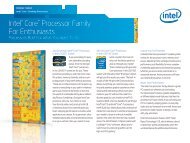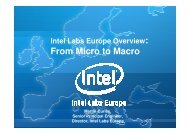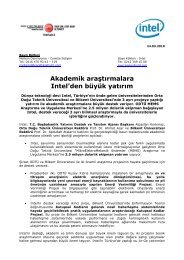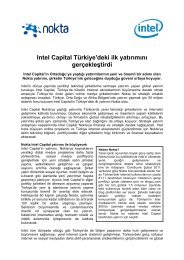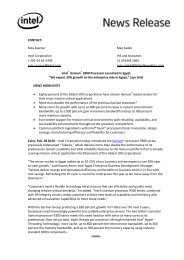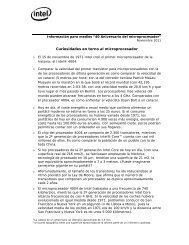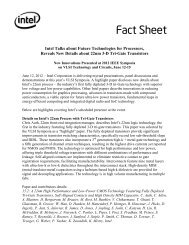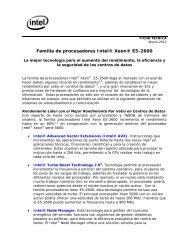Intel Makes Multi-Million Euro Investment to Create European ...
Intel Makes Multi-Million Euro Investment to Create European ...
Intel Makes Multi-Million Euro Investment to Create European ...
Create successful ePaper yourself
Turn your PDF publications into a flip-book with our unique Google optimized e-Paper software.
<strong>Intel</strong> Corporation<br />
2200 Mission College Blvd.<br />
Santa Clara, CA 95054-1549<br />
<strong>Intel</strong> <strong>Makes</strong> <strong>Multi</strong>-<strong>Million</strong> <strong>Euro</strong> <strong>Investment</strong> <strong>to</strong> <strong>Create</strong> <strong>Euro</strong>pean<br />
Exascale Computing Research Center<br />
NEWS HIGHLIGHTS<br />
• Researchers at a new <strong>Euro</strong>pean <strong>Intel</strong> lab will explore computers with a thousand times the<br />
performance of <strong>to</strong>day's fastest supercomputers.<br />
• Effort is part of <strong>Intel</strong> Labs <strong>Euro</strong>pe, <strong>Intel</strong>’s research network of 900 researchers in the<br />
<strong>Euro</strong>pean region.<br />
• <strong>Intel</strong> has committed a multi-million <strong>Euro</strong> investment <strong>to</strong>ward a new lab. CEA, UVSQ and<br />
GENCI will jointly match <strong>Intel</strong>’s contribution.<br />
PARIS, Nov. 12, 2009 – Commissariat à l'Énergie A<strong>to</strong>mique, Grand Equipement National de<br />
Calcul Intensif, <strong>Intel</strong> Corporation and Université de Versailles Saint-Quentin-en-Yvelines have<br />
entered in<strong>to</strong> an agreement <strong>to</strong> create an Exascale Computing Research Center. Part of <strong>Intel</strong>’s<br />
<strong>Euro</strong>pean research network - <strong>Intel</strong> Labs <strong>Euro</strong>pe – the center will explore how <strong>to</strong> build highperformance<br />
computing systems with a thousand times the performance of <strong>to</strong>day’s fastest<br />
supercomputers. The term “exascale” refers <strong>to</strong> computers that are able <strong>to</strong> process 1 trillion – or 1<br />
million million million – instructions per second.<br />
<strong>Intel</strong> will support the Exascale Computing Research Center with a multi-million <strong>Euro</strong><br />
investment over a 3-year period. The French A<strong>to</strong>mic Energy Commission (Commissariat à<br />
l'Énergie A<strong>to</strong>mique), the Versailles Saint-Quentin-en-Yvelines University (Université de<br />
Versailles Saint-Quentin-en-Yvelines) and the French National High-Performance Computing<br />
Agency (Grand Equipement National de Calcul Intensif) will combine <strong>to</strong> match <strong>Intel</strong>’s<br />
contribution. This is <strong>Intel</strong>’s first joint lab in <strong>Euro</strong>pe focused exclusively on high-performance<br />
computing. It will complement and extend <strong>Intel</strong>’s existing high-performance computing research<br />
programs, investments and initiatives, including the <strong>Intel</strong> Academic Community Program and<br />
<strong>Euro</strong>pean Space Agency’s “Mapping the Globe from Space” project.<br />
“France has taken a leading role in driving high-performance computing research in<br />
<strong>Euro</strong>pe,” said Steve Pawlowski, <strong>Intel</strong> senior fellow and general manager of <strong>Intel</strong> Architecture<br />
Group’s central architecture and planning. “We chose <strong>to</strong> work with these three organizations<br />
because of their world-class software competency in exascale and high- performance<br />
computing.”
<strong>Intel</strong>/Page 2<br />
-- more --<br />
The research agenda of the Exascale Computing Research Center will include integrating<br />
multi petaFLOPS systems, developing advanced performance optimization techniques, and<br />
collaborating with end users <strong>to</strong> optimize supercomputer performance in areas such as energy,<br />
seismology, computational fluid dynamics and health care.<br />
The advent of exascale is expected <strong>to</strong> enable supercomputers <strong>to</strong> solve much more<br />
complex problems than <strong>to</strong>day. For example in health care this capability should enable highly<br />
sophisticated genome calculations, enabling individualized patient treatment, or simulation of<br />
cell interactions <strong>to</strong> provide new cancer treatments. Another application can be found in<br />
seismology where exascale computing could enable more detailed prediction of ground<br />
movement at sites with high security requirements or where frequent movement is expected. In<br />
climate modeling, more accurate long-term forecasts and much more detailed local weather<br />
forecasts could be made.<br />
The Exascale Computing Research Center will combine French research expertise and<br />
high-performance computing vision with <strong>Intel</strong>’s leading products, technologies and experience in<br />
this area. The lab will employ about a dozen people initially and is expected <strong>to</strong> eventually grow<br />
<strong>to</strong> about three times that number.<br />
<strong>Intel</strong> has a rich his<strong>to</strong>ry of innovation and creativity in <strong>Euro</strong>pe with research and<br />
development programs encompassing areas such as chip design, software development, mobile<br />
communications and services, a<strong>to</strong>mic-level chip research, development of key <strong>Intel</strong> products, and<br />
research on technologies that could help the aging population <strong>to</strong> lead healthier, better lives.<br />
<strong>Intel</strong>’s research and development efforts include <strong>Intel</strong>-owned labs focused on<br />
development of <strong>Intel</strong> products, joint research with <strong>Euro</strong>pean universities, open innovation and<br />
collaboration with industry and academia, participation in EU framework programs and<br />
cooperative standards development work with industry partners that deliver increased value and<br />
productivity <strong>to</strong> consumers.<br />
About <strong>Intel</strong> Labs <strong>Euro</strong>pe<br />
<strong>Intel</strong> R&D/Innovation in <strong>Euro</strong>pe is driven by a network of research labs, product labs and<br />
innovation labs spanning the region as well as a variety of <strong>Intel</strong> business units. <strong>Intel</strong> Labs <strong>Euro</strong>pe<br />
was formally established in early 2009 as the central means of coordinating activities across this
<strong>Intel</strong>/Page 3<br />
-- more --<br />
diverse and extensive network, and <strong>to</strong> strengthen and improve <strong>Intel</strong>’s alignment with <strong>Euro</strong>pean<br />
R&D. Today, <strong>Intel</strong> Labs <strong>Euro</strong>pe consists of 19 labs employing more than 900 research<br />
professionals.<br />
About <strong>Intel</strong><br />
<strong>Intel</strong> (NASDAQ: INTC), the world leader in silicon innovation, develops technologies,<br />
products and initiatives <strong>to</strong> continually advance how people work and live. Additional<br />
information about <strong>Intel</strong> is available at www.intel.com/pressroom and blogs.intel.com.<br />
– 30 –<br />
<strong>Intel</strong> and the <strong>Intel</strong> logo are trademarks of <strong>Intel</strong> Corporation in the United States and other countries.<br />
* Other names and brands may be claimed as the property of others.<br />
CONTACTS: Stanislas Odinot Markus Weingartner<br />
+33-1-58877229 +49-89-9914-3145<br />
stanislas.odinot@intel.com markus.weingartner@intel.com



